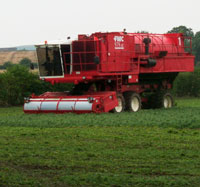Mixed results for UK pulse crop

Pea yields have been remarkably good this year, but beans have suffered badly in the drought, according to the British Edible Pulse Association (BEPA).
“Peas have ridden the spring drought very well in most areas, with yields averaging 4.5-5t/ha (1.8-2t/acre),” said president Peter Smith.
“But beans have been very variable, with yields from 2-7t/ha (0.8-2.8t/acre) depending on rainfall, with little difference between winters and springs.
“UK quality is also very variable but, overall, the UK crop is expected to be 500,000-550,000 tonnes.”
Strong oilseed rape prices were persuading many growers to increase rapeseed plantings this autumn, to the detriment of winter beans, said Mr Smith.
“But, paradoxically, winter bean seed sales have been very brisk, perhaps reflecting growers’ anxiety about over-planting rape in the rotation and the rising costs of inputs such as fertiliser.”
In France, yields were low to average, at about 3.7t/ha (1.5t/acre) for peas and 3.45t/ha (1.4t/acre) for beans – only a little above 2010.
“The French pulse acreage is also lower than forecast at 92,000ha (227,240 acres) of beans, 192,000ha (474,240 acres) of peas and 4,000ha (9880 acres) of lupins. Overall, pulses are 29% down on 2010.”
Trading was very quiet as growers took stock of their yields and quality, he added.
Feed beans were pegged at about £190-200/t ex-farm, with human consumption premiums at £15-£20 over feed.
Quality of human consumption beans was mixed, with some crops in the South East showing heavy Bruchid damage. “Splitting and staining have also been noted.”
The carryover of marrowfats from 2010 would remain an issue for another three to four months, but new crop supplies were larger, a better colour, and with less insect damage.
Blue Peas had yielded about 5t/ha (2t/acre), with premiums at £50-£60/t over feed.
“Combine this with low disease this year and it will have been a very profitable crop for the few growers left in this category,” said Mr Smith.
“Colour and grain size too are generally much improved on last year.”
Micronising peas were pegged at £205-210/t, with reports of some crops being too dry and not taking up moisture in soaking tests.

